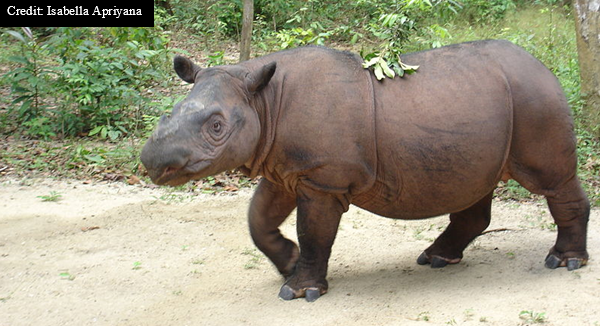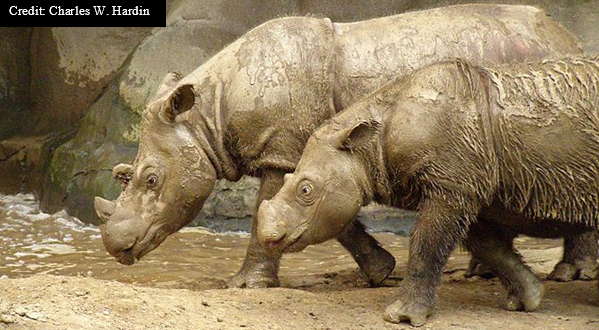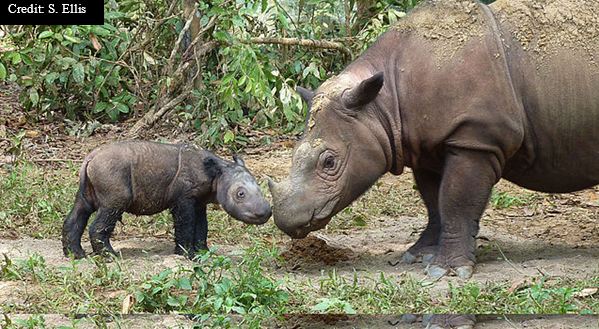Meet ICCB 2019 Mascot
The Asian Two-horned Rhinoceros (Dicerorhinus sumatrensis), also known as the Sumatran Rhinocerous, is considered Critically Endangered due to habitat loss and poachers who sell various body parts that have alleged (but unlikely) medicinal applications. Its current range has been reduced to a few isolated populations in Sumatra and Borneo. Studies in the wild have shown that these wide-ranging rhinos feed on over 100 species of plants, and change their diet when feeding in different parts of their range. This indicates that they can be linked to a wide diversity of other species. Their survival is dependent on significant conservation action that includes effective protected area management, anti-poaching efforts, broad public support for their restoration, and research that can be applied to their conservation in the field.
Fun Facts about the Asian Two-horned Rhinoceros:
- The Asian two-horned rhino is the smallest rhino, at only an average of 1,760 pounds and a maximum height of 5 feet tall at the shoulders.
- The Asian two-horned rhino is the hairiest rhino. They use this hair to keep mud caked to their body to cool them and protect them from insects.
- The Asian two-horned rhino is one of the most vocal rhino species and communicates using many different sounds including whistling or whining noises. Some of their noises have even been described as sounding like a humpback whale!
- Asian two-horned rhinos are the only Asian rhinos with two horns. The first horn is larger than the second and both are used for scraping mud from the sides of wallows, pulling down plants for food, and protecting the head while walking through dense forest vegetation.
- The Asian two-horned rhino is the closest living relative to the wooly rhinoceros that lived during the ice-age.
- The Asian two-horned rhino spends a large part of their day wallowing in mud holes to keep cool and protect them from insects.
The Asian Two-horned Rhinoceros in the News:
- Humans are Sumatran rhinoceros' biggest threat—and last hope
- Is anyone going to save the Sumatran rhino?
- Sumatran rhinos nearing extinction due to farming, hunting
- Sumatran rhino 'hanging on by a thread'
- The Sumatran Rhino Has Been on The Brink of Extinction For 10,000 Years
Recent Asian Two-horned Rhinoceros Research:
- Will current conservation responses save the Critically Endangered Sumatran rhinoceros Dicerorhinus sumatrensis?
- Rhinos in the Parks: An Island-Wide Survey of the Last Wild Population of the Sumatran Rhinoceros
- Genetic variation of complete mitochondrial genome sequences of the Sumatran rhinoceros (Dicerorhinus sumatrensis)
Sources: National Geographic, Save the Rhino International, International Rhino Foundation
ICCB 2019 Theme
Conservation beyond Boundaries: Connecting Biodiversity with Communities, Governments and Stakeholders
The theme of ICCB 2019 recognizes the challenges of conserving biodiversity across political and cultural boundaries. Biodiversity does not recognize human-drawn boundaries, but the latter can have major impacts on the biosphere through social, political and economic structures. Conserving biodiversity beyond boundaries requires communication and collaboration between countries, government agencies and NGOs, and communities, and across fields of knowledge. Threats to species and ecosystems, such as commercial wildlife trade, infrastructure, and expansion of the human footprint reach beyond boundaries. To achieve targets for sustainable development, conservation solutions must be achieved through collaboration, dialogue and decision-making at local, regional and global scales.






